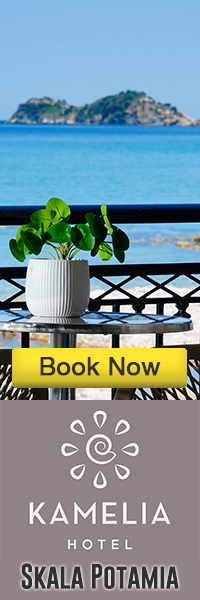History & Myth
History of Thassos
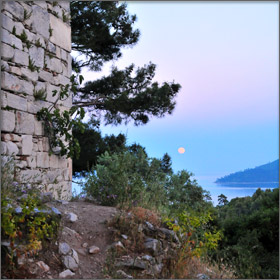
Thassos today is known as the “Emerald Island” due to the lush vegetation and forests that make this island such a beautiful holiday destination. However in ancient Greece it was known as “The Athens of the North”, a title confirming the considerable reputation the island enjoyed. Rich in minerals and natural resources and strategically positioned on the main trade route linking Anatolia and central Greece and beyond, the island has been coveted by all the great powers of antiquity. The Athenians, Spartans, Persians and the Romans all targeted the island for invasion and did so when the opportunity arose.
To delve a little into the fascinating story of the island, a good place to start is the archaeological museum in Thassos Town (known locally as Limenas). Renowned as one of the principle museums in Greece, it is highly recommended for a visit during your stay on the island. The exhibits range from monumental sculptures to the most delicate ancient gold jewelry excavated from sites all over the island. The story of Thassos throughout its history is set out in chronological order as you move from room to room, giving the visitor a fascinating insight into this historically important island.
Limenas is the modern day capital of the island as it was in ancient times, a fact that becomes evident when you explore the town, as around every corner you come face to face with remnants of its ancient past. The main archaeological sites are the agora (ancient marketplace), the sanctuaries to the gods Herakles, Dionysus, Artemis and Poseidon. Venturing up to the acropolis which also offers magnificent views of the town and bay below, you will find the ancient theatre, the remains of the temples to Apollo and Athena and the sanctuary of Pan. Circling Limenas and in easy walking distance from the centre are the remains of the monumental city-wall that rose up to 9 metres high and was predominantly constructed out of gleaming white Thassian marble. Marvel at the gargantuan blocks of stone constructed with such precision that even today a credit card cannot be inserted between them. At intervals around these impenetrable defences were magnificently decorated gates that provided the only entrances to the ‘fairy-tale’ city of white marble within.
Ancient Times
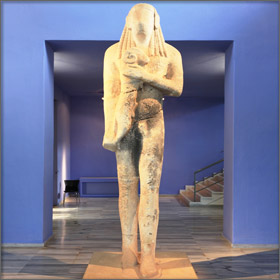
The first recorded history of Thassos tells of how the citizens of Paros (an island in the southern Aegean) colonised the island in the early 7th century B.C. It is not clear whether they were invited by the Thassians or invaded, but the story tells of now their leader Telesicles had to first visit the oracle at Delphi to request divine guidance from the god Apollo. The prophesy received by Telesicles and recorded reads “Tell the Parians Telesicles, that I have ordered you to build upon the Isle of Aeria (an ancient name for Thassos), a great city that will be visible from all around.” And so in 680 B.C. he arrived on the island with his army and chose the site of modern day Limenas for the new capital city. As you explore, pick up a piece of Thassian marble and try to imagine a whole city built of this sparkling white stone, you will then realise that Telesicles achieved all that Apollo asked of him.
To protect their great city, the Thassians built one of the largest navies in the Aegean, only surpassed by Athens herself. What is now the ‘Old Harbour’ was originally the ‘War Harbour’ which housed up to 60 Triremes (the warships of the time) and was itself heavily fortified with walls and towers.
By the early years of the 5th century B.C., the Persian Empire under King Darius I had conquered much of the northern coast of Greece. The powerful city-state of Thassos, although remaining independent, was viewed by Darius as a threat to his borders and so he forced the islanders to surrender their entire navy and to dismantle sections of the formidable fortifications. After the defeat of the Persians in Greece in 480 B.C. (the year of the famous Battle of Thermopylae), the Thassians restored the fortifications and rebuilt their navy. However, after having allied themselves with the powerful state of Athens, in 465 B.C. they left the alliance due to the heavy taxes imposed by the Athenians. Not willing to accept their defection, Athens attacked the island and after two years of siege Thassos capitulated. The penalty imposed on the island was once again the surrender of the navy and the partial destruction of the rebuilt city walls.
Consequently, during this period, the island required a continuous supply of building materials, the timber coming from the extensive forests that you still see to this day and stone from the colossal marble quarries at Aliki on the southern coast of the island. Aliki (a corruption of the ancient name of Alki meaning ‘power’) is now a beautiful setting for a day on the beach. However, a walk around the peninsula will bring you to these ancient quarries, where you can see half-finished blocks still showing the tool marks and confirming how they were shaped and cut free from the bedrock. The use of the quarry came to an abrupt end in the 7th century A.D., testified to by immense columns and bases that have just been left where they lay. Thassian marble was highly valued in the ancient world and was one of the main exports from the island as it continues to be today, with the modern quarries being situated at the north of the island near to the village of Panagia.
Roman and Byzantine Times
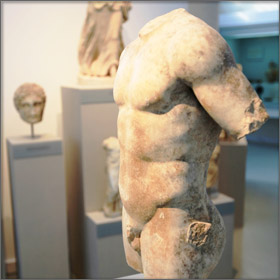
During the Roman and Byzantine Period Thassos ruled a large area of the mainland including the most famous of Thassos’ colonial cities, Philippi, whose vast ruins lie 19km outside the modern day city of Kavala. Philippi is steeped in history from its connections with early Christianity, as it was here that Saint Paul taught the early Gospels, to the famous ‘Battle of Philippi, when in 42 B.C. the army of Brutus and Cassius, the main conspirators in the murder of Julius Caesar, met those of Mark Antony and Octavian for a final showdown. It was on the fields of Philippi that the future of Rome was decided and inevitably that of Europe.
Thassos continued as an important province within the Roman Empire under rule from Rome until 330 A.D., when the capital of the Holy Roman Empire moved to Constantinople and Thassos became part of what is now termed the Byzantine Empire.
During the Byzantine period, invasions and piracy were a major problem for the island and from the 7th century A.D., an intensification of raids forced the inhabitants to move from the shoreline and build villages further up the mountains, hence the dual villages, one at sea level (Skala) and one further inland.
During the 13th and 14th centuries Thassos continuously changed hands between the Byzantines, the Venetians and the Genoese. In 1414, the Genoese Lord Jacomo Gattilusi seized the island and attempted to revive the significance of Thassos by rebuilding part of the ancient city, especially the Acropolis. He then invited his compatriots from Italy to come live on his fiefdom on the island. His family ruled the island until 1455 when the Turks took the island over. During the Turkish occupation of 1455 to 1770 the Turks deported most of the citizens and the island was left uninhabited. The Russian/Turkish war of 1770 saw the island seized by the Russians, in 1774 the island returned to Turkish rule.
Post-Ottoman Times
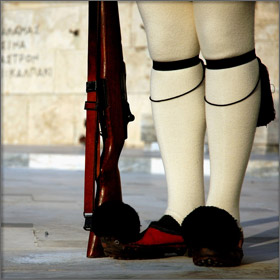
In 1813, Thassos was granted by the Turkish Sultan to the Vizier of Egypt, Mehmet Ali, who was the founder of the Basilica Dynasty of Egypt. He was born in Kavala but raised by a family in the village of Rachoni on Thassos. Out of gratitude, Mehmet Ali freed the island from most taxes, but even this act didn’t pacify the Thassians and in 1821 they unsuccessfully rebelled against Egyptian rule, led by the chieftain Chadjigeorgis Metaxas from Theologos. After the failure of the revolt, Metaxas left the island, accepting responsibility to prevent reprisals against the population. In 1902 new taxes sparked further unrest, resulting in the end of the Egyptian administration of the island and the beginning, once again, of the Turkish occupation. In 1912 it was liberated by the Greek navy, a year later becoming officially part of the Greek state.
Modern Times
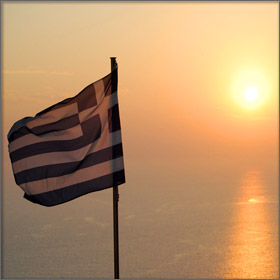
During the Second World War, Greece was first unsuccessfully invaded by Italy, but as allies of Italy diverted forces to aid the Italians and in 1940 the Axis forces defeated the Greek army and occupied the country. The Greeks suffered enormously under the German administration, both through starvation and severe restrictions. Later the Germans handed the administration over to their allies the Bulgarians, who’s military and political authorities continued the severe treatment of the local population, until in November 1944 the Axis forces in Greece surrendered.
The Greek civil war (1946 - 1949) was the first example of a post-war communist insurgency in Europe. The victory of the anti-communist government forces led to Greece's membership in NATO and defined the ‘Cold War’ balance of power in the Aegean.
Today, Thassos is the main holiday destination in the northern Aegean for western Europeans. In recent years, since the fall of the “Iron Curtain”, the island has also become a popular destination for eastern Europeans, especially from the Balkan countries. However, whatever your nationality, once visited, this beautiful island will entice you back time and again, a fact that has gained Thassos the impressive reputation of receiving the most return visits of any Greek island!
Mythology of Thassos
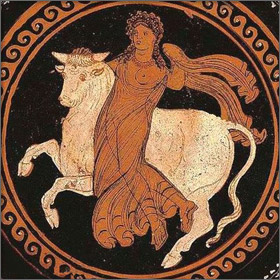
Although the island has been known by many names through its long history such as Aeria (translated as ‘cool summer breezes’), Aethria (‘clear blue skies’), Chrisia (‘gold’) and Thassos, the latter, although not descriptive, is the name that has endured into the modern day. One question that many visitors ask is “where did the name Thassos originate?” Whereas no conclusive evidence of its origin exists, one of the ancient myths of Zeus, the greatest and mightiest god of the ancient Greeks, refers to the island’s naming.
The story goes that in the far distant past, Agenor the King of Eastern Phoenicia, had four sons, Phoenix, Cilix, Cadmus and Thassos and one daughter, Europa. One spring day, Zeus transformed himself into a bull, kidnapped the buxom Europa and carried her on his back to the Dictaean Cave in Crete. There, in the form of a handsome eagle, Zeus coupled with Europa, and from that sacred union three sons were born: Minos, the famous King of Crete, Rhadamanthys, the wise lawgiver, and Sarpedon, the first King of Lycia. Europa, aware that her father disapproved of the liaison with Zeus, hid from him in Crete whilst continuing to enjoy Zeus’ favours.
Agenor enraged at Zeus’ actions, ordered his sons to look high and low for Europa and not to return unless they found her. Phoenix set out towards the south, Cilix went north until he reached a fertile land where he made himself king, since then it has been known as Cilicia. Cadmus, after unsuccessfully searching through the Greek islands, continued his quest on mainland Greece. He visited the Oracle of Apollo at Delphi and consulted the Pythian priestess. Although he followed her advice, he was still unable to find Europa. After passing through Phocis, he came to Boeotia, where he built an acropolis, Cadmeia, and below it a town with broad avenues, naming it Thebes. Thassos searched for Europa in various places until he came to an island off Thrace. Captivated by its marvellous climate and lush vegetation and unable to return to his father without Europa, he gave up his quest. Thassos and his retinue settled on the island, which has borne his name ever since.
Herodotus, the greatest historian of antiquity, is categorical on this matter. He says the island is “now called after that Phoenician Thassos” (Herodotus, Histories, 6.47.1).
I hope that this brief introduction to the history & myth of Thassos has confirmed that for those who are intrigued by the past, the island and the nearby mainland offer a multitude of places to visit and explore.

Tony's Recommended Places to Visit on Thassos (off the beaten track)
For those interested in delving deeper into Thassian ancient history, archaeological sites can be found scattered around the island, such as a 3rd century B.C. well behind the beach in Chrisi Amoudia (Golden Beach) and on the headland above, the ruins of a 4th century B.C. Pharos (lighthouse). Further round the island in Skala Sotiras, nestled under the village church, are the remains of an early bronze-age fortified stronghold, the power base of a regional warlord of the 3rd millennium B.C.


